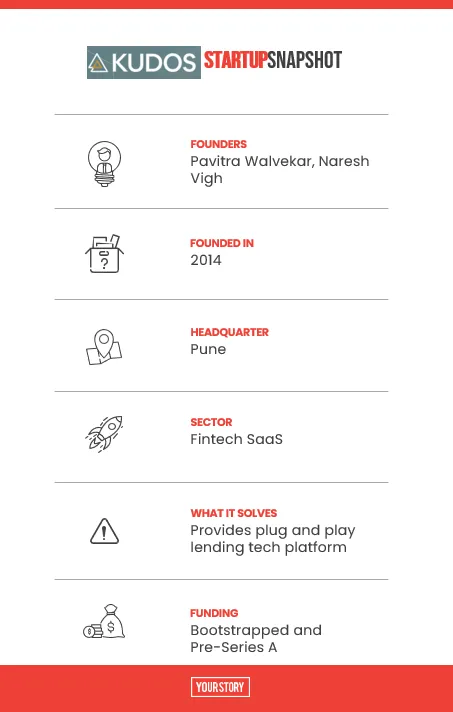How a brick-and-mortar NBFC pivoted to become a tech-enabled finance-SaaS startup
Pune-based SaaS fintech startup Kudos Finance is enabling lending businesses set up a plug-and-play solution to go digital.
In 2014, Pavitra Walvekar launched , a full-fledged NBFC providing loans to small businesses with branches across different cities in India. Until 2018, the Pune-based NBFC had three branches and had disbursed about Rs 100 crore in loans.
But the change came when Pavitra met an entrepreneur who was launching an expense management card for cab drivers to keep a tab on their fuel expenditure.
The three key insights from this for Pavitra was: firstly there was an end-user control, which meant that it was being used only for a particular expense, secondly, the cash flow was tracked, and lastly, it was all done digitally.
“This was a better way of lending and we moved from traditional centralised way of lending to what we are today - decentralised lending,” Pavitra tells YourStory.

Going digital and enabling others to do so
As Kudos Finance already had all the ingredients needed to be an NBFC — a licence, framework for verification of customers, and lenders on board — and also in-house technology, the startup decided to open its doors for others to launch their operations of providing loans through their platform.
Once it got into the digital mode, Kudos trimmed down to a single office but the reach remained exponential owing to its digital network.
Today, Kudos Finance works as a software as a service (SaaS) fintech startup, where others can come just have a plug-and-play operation and focus only on their customers, with the rest being taken care of by the platform.
“We are an infrastructure layer platform that allows any fintech or marketplace launch its own credit product using our full stack digital lending capability,” says Pavitra.
This means anybody who wants to get into the lending part of the financial services world can use the Kudos Finance platform for almost everything — the tech stack, creditors in the form of banks or NBFCs, customer verification services, payment gateway, digital collections, etc.

The founder says that all that customers have to do is focus on their core competency of product innovation and distribution to target their own set of customers.
It has around 25 customers, which include fintech startups and digital marketplaces. These companies are from sectors such as educational finance, agri finance, revenue-based financing, etc.
“What we have solved is the removal of friction where one can go live within one week’s time,” says Pavitra.
Also, Kudos Finance has 11 lenders on its platform, which includes four banks and seven NBFCs.
Requirements
Any company looking to plug onto Kudos Finance’s platform to launch their operations has to meet certain conditions. Firstly, it has to have an API framework, the tenure of loans disbursed has to be of a short duration of 15 days to a year, ticket size should be of a few thousand rupees to Rs 10 lakh, the company should have end-user control, and lastly, it should be able to track the cash flow.
Pavitra says Kudos Finance enables all kinds of digital lending and it constantly evaluates any kind of new use cases to integrate them on to the platform.
This pivot and the new strategy paid rich dividends as the startup claims that over Rs 2,600 crore has been disbursed through its platform to one million customers, who are present in 2,100 cities with just a 44 member team and a single branch.

Passing the COVID-19 test
This growth for Kudos Finance also withstood the pressure of the pandemic, where there were high cases of loan defaults and credit given to customers sits on the loan book of this startup.
Though, Pavitra says its model successfully passed the COVID-19 test as the loans were of smaller ticket size coupled with its mechanism of digital tracking and end-user control.
Kudos Finance also ensures that loans that are given are also collected as these accounts are on its financial books. Towards this end, it has a policy where the company leveraging its platform for giving out loans gets paid its commission only when the repayment is done.
“The loan defaults on our books is just 0.1 percent,” says Pavitra.
The pandemic also helped Kudos Finance as there was a considerable uptick in digital lending.
The USP of Kudos Finance is that it has got both the tech platform and an NBFC setup where it does not compete with any of its partners. “That is our competitive float,” he adds.
According to the Reserve Bank of India, the addressable credit demand from the country’s MSME segment is around $490 billion.
However, traditional lenders like banks or NBFCs are unable to address this requirement as they follow norms of lending which requires physical guarantee while fintechs leverage technology to assess the creditworthiness of the borrower without seeking such surety.
For Kudos Finance, its competition comes from other largely overseas companies such as Tink, Railbank, Deposit Solution etc.
Funding and future
According to Pavitra, Kudos Finance has always been profitable since inception, and claims that the startup remained profitable even during the height of the pandemic.
Kudos Finance was bootstrapped until this April when it raised an undisclosed round of Pre-Series A funding from angel investors such as Nithin Kamath of Zerodha, Nischal Shetty of WazirX, Sumit Maniyar of Rupeek, etc.
On the funding round, Pavitra says, “It is more towards backing of vision and we also need social capital where we can reach out these individuals immediately if I need any answers.”
Moving forward, the startup aims to be the de-facto platform for anybody who wants to launch a digital lending product for their own set of customers.
“We will constantly reduce the level of friction as much as possible and be the go-to platform for finance,” says Pavitra.
Edited by Saheli Sen Gupta










